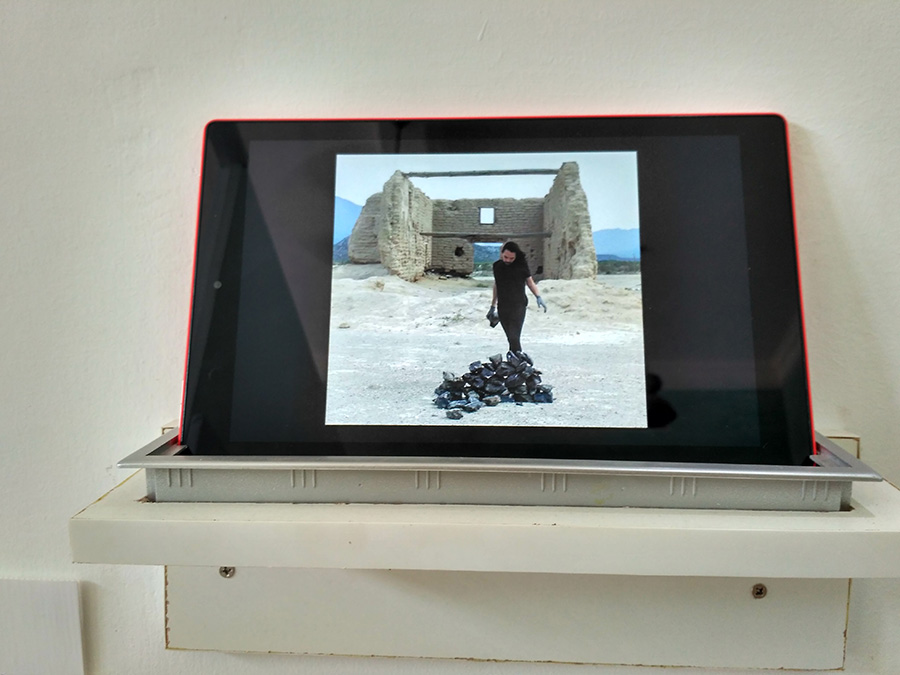YANGON—An artist finds himself at home, with a desperately ringing telephone. But our dialogues are distorted today, so much so that we cannot dial each other up and talk about animals living in gas masks in the near future. Everyone must do something. At the least, we can all open doors and build bridges.
This disorientation is just one of the elements on display at Building Bridges Yangon, a new media art exhibition at the Old Tourist Burma Building. This multi-sensory event, featuring the works of young local and international artists, can safely be considered one of the major artistic events in Yangon so far this year.
This exotic show, featuring artists from as far as Mexico and Ireland, offers an exquisite, eclectic mix of original new-media experiences, spanning from augmented reality (AI) and video installations to noise art.
Immediately at the entrance, WEER and Noise in Yangon summons the visitor to a cozy Looming Thread cubicle of textile and sound. Once the viewer has exited this winding journey, stepping beyond overhanging threads, communicating with the self is revolutionized, and a new bridge is formed within.
At the exhibit, Myanmar artists tend to explore the religious, the political and the social, while their international fellows mostly revel in expressionism. But at their best, the works of these artists—all under 30—cannot be reduced to a tidy set of predicable styles. The Chinese-American artist Dengke Chen, for example, wakes you up today to nurse the planet earth tomorrow in his engaging AI installation Humanimal Kingdom, while Indian-born Ashok Vis’s A Retelling explores the myths of gender identity through his eyes.
The five artworks selected below are described in the ascending order of the length of time we stood and stared at each—not by their merit.
If you have visited Building Bridges Yangon or plan to visit before its closing, on July 31 (a particularly good time to visit is July 27, at 4:45 p.m., when there will be a 60-minute, artist-guided tour), list your favorites in the comments below.

Inside Out
Window and door images of every sort are common. Really, a door itself is a picture. But you may never have seen such photographs breathe as deeply as those in Indian artist Bhargav Barla’s Inside Out. A partially open window, blurred with grime, reluctantly offers a sneaking view of a few trees outside. The missing door of a ramshackle building is replaced with a seaside horizon and tide. A tightly closed window silently moans as an airplane flies past. There is an insatiable curiosity inherent in such imagery that keeps us there, in front of the image, lost somewhere between wanting more inside and receiving little outside. With great synergy between viewer and view, Bhargav frees us from this temptation to see beyond.
Time, Thoughts, Incoherent
Sonam Chaturvedi says the purpose of her audio-visual installation is “to disorient and distort the memory of listeners,” and by that metric she succeeds. Specializing in Interdisciplinary Visual Arts in her postgraduate studies, this Indian-born artist daringly offers us a palm-sized photobook (11.43 cm by 15.24 cm) complimented by manipulated audio. Since the photos are folded in half then stacked and bound together, to see the full picture of a particular page the viewer must first find its other half from the back side of the image. The close-up of an eye and a finger, for example, are apparently divided in two pieces on either side of their respective pages. Sequentially, these half images appear side by side. As an unintelligible sound plays in loop, this (physically) tiny installation is nothing if not surreal.

Rise and Fall of Paradigm
If there were a prize for the most original concept, it would surely go to Alejandro Zertuche’s 46-second stone-piling GIF and nine accompanying blueprints. Obsidian glass is believed to have deep psychic power and wide-ranging practical uses, in both modern and prehistoric times—be it an arrowhead or a scalpel blade. The Mexican-born artist says this mysterious material, once ablaze in a volcanic explosion, is a sacred item to the Mexican God Tezcatlipoca, who uses an obsidian black mirror as a dimensional portal to look into other times and to kill his enemies. Reminiscent of the Myth of Sisyphus, an endless loop of a 46-second video plays of a long-haired man stacking obsidian stones, one atop the other, until they form a two-dimensional, triangular pile that, again and again, falls over. Beside this, the anatomy of an obsidian stone is displayed in nine blueprints. For Zertuche, art can arise from anything—occult practice, architecture or mythology.

Home
Now we’re back in India, in the Home of 23-year-old artist Souvik Majumdar. It’s 1:06, but we don’t know if it’s early morning or afternoon—a clock in a photo, after all, is correct twice a day. Curiosity arises. A phone rings. We have to desperately find it among the varied paraphernalia of an artist’s home—crammed rubbish bins, a flower bed, a calendar, a clock, piles of ragged books, unnamable objects.
Because renovations at the Old Tourist Burma Building are still underway, every audio installation shares one thing in common: each audio clue we are given melts into the sounds of life in the background. Distracting as the screeching and clacking of construction may be, it also intensifies our presence in the Home exhibition.

Distorted Dialogue
This hypnotic experimental video is positioned in a quiet enclave of the exhibition room that shares the same hue as the two translucent seas the video projects onto either of its sides. At one point, two superimposed female silhouettes appear to be in conversation along the shore, while at another point each sits alone, or inches towards the waves. A chair overtakes the view. You might think you can see the otherness in the video but, Burmese filmmaker Khin Thet Htar Latt’s says, “There is no dialogue between [them]. Everything is distorted.”

















